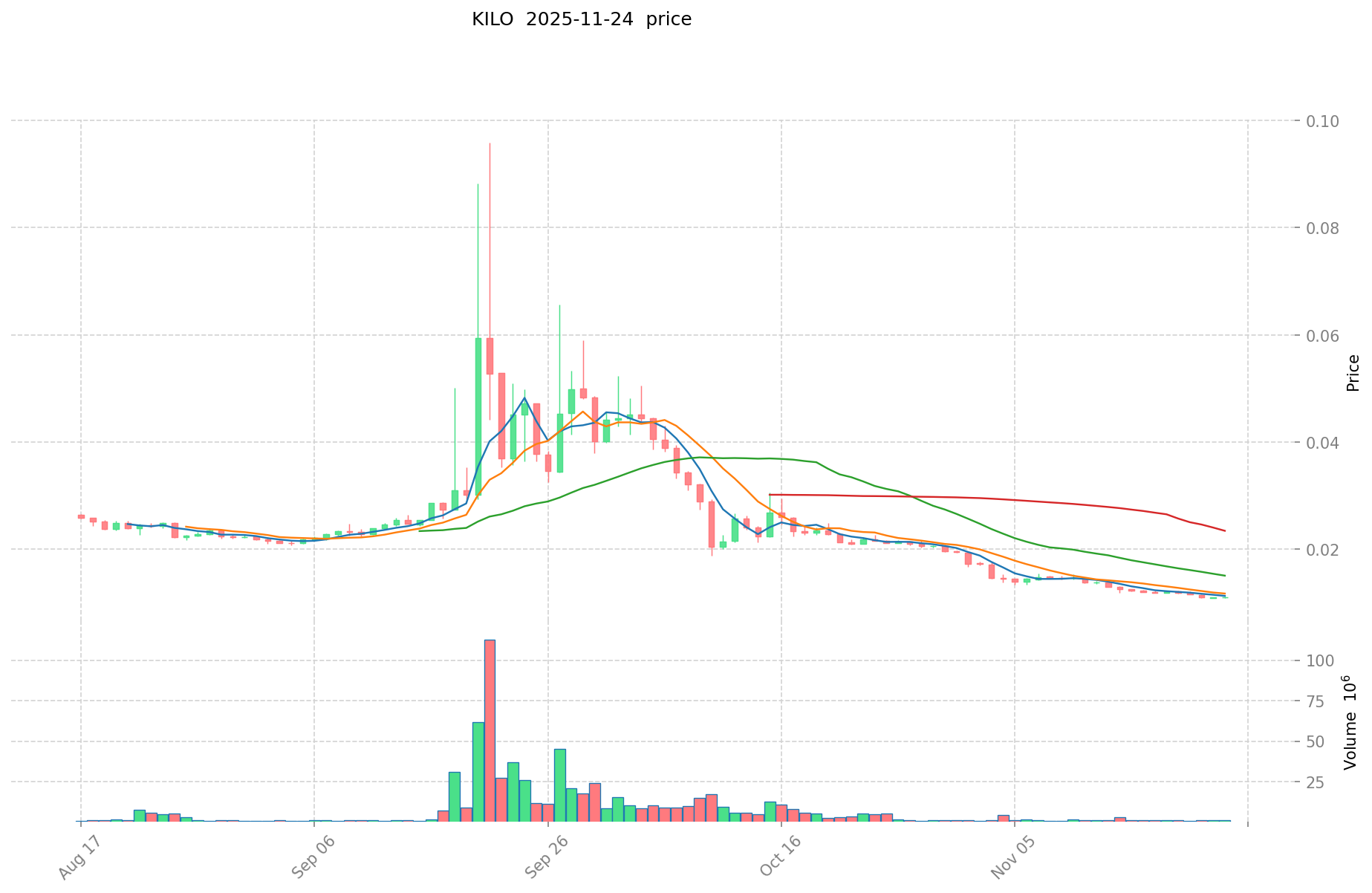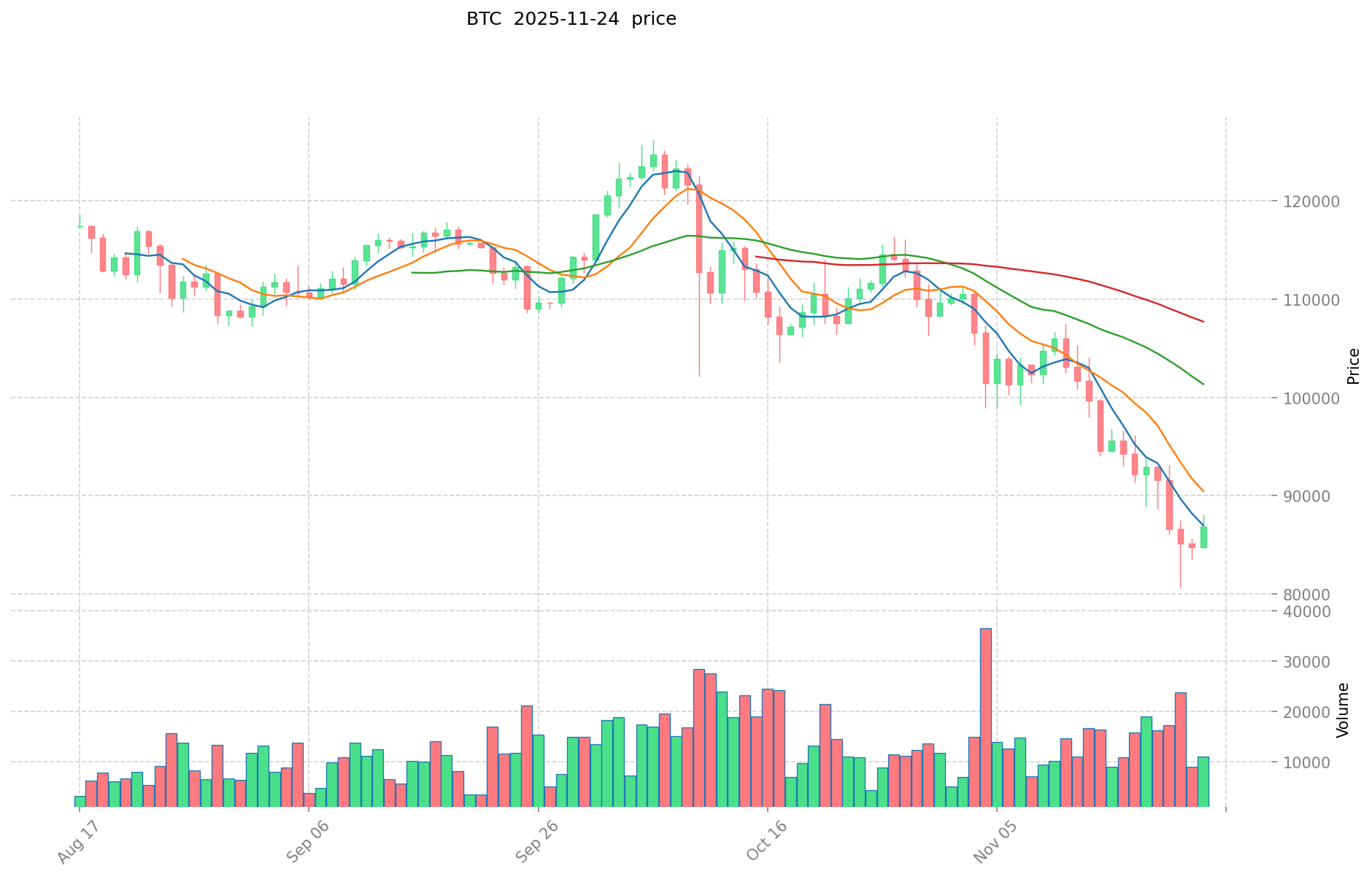KILO vs BTC: The Battle for Dominance in the Digital Asset Arena
Introduction: KILO vs BTC Investment Comparison
In the cryptocurrency market, the comparison between KILO and BTC has always been an unavoidable topic for investors. The two not only differ significantly in market cap ranking, application scenarios, and price performance but also represent different positioning in the crypto asset space.
KILO (KILO): Launched in 2025, it has gained market recognition for its focus on risk management and capital efficiency in decentralized perpetual contracts.
BTC (BTC): Since its inception in 2008, it has been hailed as "digital gold" and is one of the cryptocurrencies with the highest global trading volume and market capitalization.
This article will comprehensively analyze the investment value comparison between KILO and BTC, focusing on historical price trends, supply mechanisms, institutional adoption, technological ecosystems, and future predictions, attempting to answer the question investors care about most:
"Which is the better buy right now?"
I. Price History Comparison and Current Market Status
KiloEx (KILO) and Bitcoin (BTC) Historical Price Trends
- 2025: KILO reached its all-time high of $0.162 on March 27, 2025, and its all-time low of $0.010832 on November 21, 2025.
- 2025: BTC hit a new all-time high of $126,080 on October 7, 2025.
- Comparative analysis: In 2025, KILO experienced a significant drop from its high of $0.162 to its current price of $0.010947, while BTC has shown more resilience, currently trading at $87,533.7 after reaching its all-time high.
Current Market Situation (2025-11-24)
- KILO current price: $0.010947
- BTC current price: $87,533.7
- 24-hour trading volume: KILO $10,419.76 vs BTC $1,001,360,347.91
- Market Sentiment Index (Fear & Greed Index): 19 (Extreme Fear)
Click to view real-time prices:
- View KILO current price Market Price
- View BTC current price Market Price


II. Key Factors Influencing KILO vs BTC Investment Value
Supply Mechanism Comparison (Tokenomics)
- KILO: Limited total supply of only 21 million tokens, same as Bitcoin's maximum cap
- BTC: Fixed supply cap of 21 million coins with halving mechanism every 4 years, creating cyclical supply reduction
- 📌 Historical Pattern: Fixed supply mechanisms tend to create scarcity-driven price appreciation cycles, particularly visible during Bitcoin's post-halving periods.
Institutional Adoption and Market Applications
- Institutional Holdings: Bitcoin maintains significant lead with established institutional adoption through ETFs, corporate treasury allocations, and regulated futures markets
- Enterprise Adoption: Bitcoin serves as primary treasury reserve asset for many companies, while KILO lacks documented enterprise implementation
- Regulatory Attitudes: Bitcoin faces varying regulatory approaches globally but has achieved legal tender status in countries like El Salvador; KILO's regulatory status remains largely undefined across jurisdictions
Technical Development and Ecosystem Building
- KILO Technical Features: Built on Solana blockchain for high throughput and low fees, featuring wrapped Bitcoin functionality
- BTC Technical Development: Layer-2 solutions including Lightning Network for scalability, Taproot upgrade enhancing privacy and smart contract functionality
- Ecosystem Comparison: Bitcoin's ecosystem includes robust DeFi applications, growing NFT functionality via Ordinals, and widespread payment infrastructure; KILO's ecosystem remains in early development phase
Macroeconomic Environment and Market Cycles
- Inflation Performance: Bitcoin has established track record as inflation hedge during monetary expansion periods; KILO's inflation resistance properties remain theoretical
- Monetary Policy Impact: Federal Reserve policies and dollar strength typically create inverse correlation with Bitcoin price movements
- Geopolitical Factors: Bitcoin demonstrates increasing adoption in regions with currency instability and cross-border payment restrictions
III. 2025-2030 Price Prediction: KILO vs BTC
Short-term Prediction (2025)
- KILO: Conservative $0.00572312 - $0.011006 | Optimistic $0.011006 - $0.0121066
- BTC: Conservative $48,156.02 - $87,556.4 | Optimistic $87,556.4 - $118,201.14
Mid-term Prediction (2027)
- KILO may enter a growth phase, with expected prices ranging from $0.01212486996 to $0.01790533122
- BTC may enter a bullish market, with expected prices ranging from $104,689.436352 to $162,486.729338
- Key drivers: Institutional capital inflow, ETF, ecosystem development
Long-term Prediction (2030)
- KILO: Base scenario $0.023134103847477 - $0.025447514232224 | Optimistic scenario $0.025447514232224
- BTC: Base scenario $144,023.8748253552 - $181,470.082279947552 | Optimistic scenario $181,470.082279947552
Disclaimer: This analysis is for informational purposes only and should not be considered as financial advice. Cryptocurrency markets are highly volatile and unpredictable. Always conduct your own research before making any investment decisions.
KILO:
| 年份 | 预测最高价 | 预测平均价格 | 预测最低价 | 涨跌幅 |
|---|---|---|---|---|
| 2025 | 0.0121066 | 0.011006 | 0.00572312 | 0 |
| 2026 | 0.016641072 | 0.0115563 | 0.007511595 | 5 |
| 2027 | 0.01790533122 | 0.014098686 | 0.01212486996 | 28 |
| 2028 | 0.0230428923984 | 0.01600200861 | 0.0108813658548 | 46 |
| 2029 | 0.026745757190754 | 0.0195224505042 | 0.01171347030252 | 78 |
| 2030 | 0.025447514232224 | 0.023134103847477 | 0.012261075039162 | 111 |
BTC:
| 年份 | 预测最高价 | 预测平均价格 | 预测最低价 | 涨跌幅 |
|---|---|---|---|---|
| 2025 | 118201.14 | 87556.4 | 48156.02 | 0 |
| 2026 | 115224.2224 | 102878.77 | 95677.2561 | 17 |
| 2027 | 162486.729338 | 109051.4962 | 104689.436352 | 24 |
| 2028 | 141199.87727976 | 135769.112769 | 122192.2014921 | 55 |
| 2029 | 149563.2546263304 | 138484.49502438 | 78936.1621638966 | 58 |
| 2030 | 181470.082279947552 | 144023.8748253552 | 116659.338608537712 | 64 |
IV. Investment Strategy Comparison: KILO vs BTC
Long-term vs Short-term Investment Strategies
- KILO: Suitable for investors focused on DeFi innovations and high-growth potential in emerging ecosystems
- BTC: Suitable for investors seeking established market presence and potential inflation hedge
Risk Management and Asset Allocation
- Conservative investors: KILO: 10% vs BTC: 90%
- Aggressive investors: KILO: 30% vs BTC: 70%
- Hedging tools: Stablecoin allocation, options, cross-currency portfolios
V. Potential Risk Comparison
Market Risk
- KILO: Higher volatility due to lower market cap and liquidity
- BTC: Susceptible to macroeconomic factors and regulatory news
Technical Risk
- KILO: Scalability concerns, network stability on Solana
- BTC: Mining centralization, potential security vulnerabilities
Regulatory Risk
- Global regulatory policies may impact both differently, with BTC having a more established regulatory framework
VI. Conclusion: Which Is the Better Buy?
📌 Investment Value Summary:
- KILO advantages: Innovative DeFi features, potential for high growth
- BTC advantages: Established market leader, proven track record, wider adoption
✅ Investment Advice:
- New investors: Consider a BTC-heavy portfolio with small KILO allocation for diversification
- Experienced investors: Balanced approach with higher KILO allocation based on risk tolerance
- Institutional investors: Focus on BTC for regulatory clarity, consider small KILO position for potential growth
⚠️ Risk Warning: Cryptocurrency markets are highly volatile. This article does not constitute investment advice. None
VII. FAQ
Q1: What are the main differences between KILO and BTC in terms of investment potential? A: KILO is a newer cryptocurrency focused on decentralized perpetual contracts, with potential for high growth but higher volatility. BTC is the established market leader with a longer track record, wider adoption, and is often seen as a digital store of value.
Q2: How do the supply mechanisms of KILO and BTC compare? A: Both KILO and BTC have a limited total supply of 21 million tokens/coins. However, BTC has a halving mechanism every 4 years, which creates cyclical supply reduction, while KILO's supply mechanism details are not specified in the given information.
Q3: Which cryptocurrency has better institutional adoption? A: Bitcoin (BTC) has significantly better institutional adoption, with established ETFs, corporate treasury allocations, and regulated futures markets. KILO lacks documented enterprise implementation at this stage.
Q4: How do the current market prices and trading volumes of KILO and BTC compare? A: As of 2025-11-24, KILO's price is $0.010947 with a 24-hour trading volume of $10,419.76. BTC's price is $87,533.7 with a 24-hour trading volume of $1,001,360,347.91. BTC has a much higher price and significantly larger trading volume.
Q5: What are the key technical features of KILO and BTC? A: KILO is built on the Solana blockchain, offering high throughput and low fees, and features wrapped Bitcoin functionality. BTC has Layer-2 solutions like the Lightning Network for scalability and the Taproot upgrade for enhanced privacy and smart contract functionality.
Q6: How do analysts predict the prices of KILO and BTC will change by 2030? A: By 2030, KILO is predicted to reach between $0.023134103847477 and $0.025447514232224 in the base scenario. BTC is expected to reach between $144,023.8748253552 and $181,470.082279947552 in the base scenario.
Q7: What investment strategies are recommended for KILO and BTC? A: For conservative investors, a portfolio allocation of 10% KILO and 90% BTC is suggested. For aggressive investors, the recommendation is 30% KILO and 70% BTC. New investors might consider a BTC-heavy portfolio with a small KILO allocation for diversification.
Q8: What are the main risks associated with investing in KILO and BTC? A: KILO faces higher volatility due to lower market cap and liquidity, as well as potential scalability concerns. BTC is susceptible to macroeconomic factors and regulatory news, with risks of mining centralization and potential security vulnerabilities. Both face regulatory risks, though BTC has a more established regulatory framework.
Share
Content